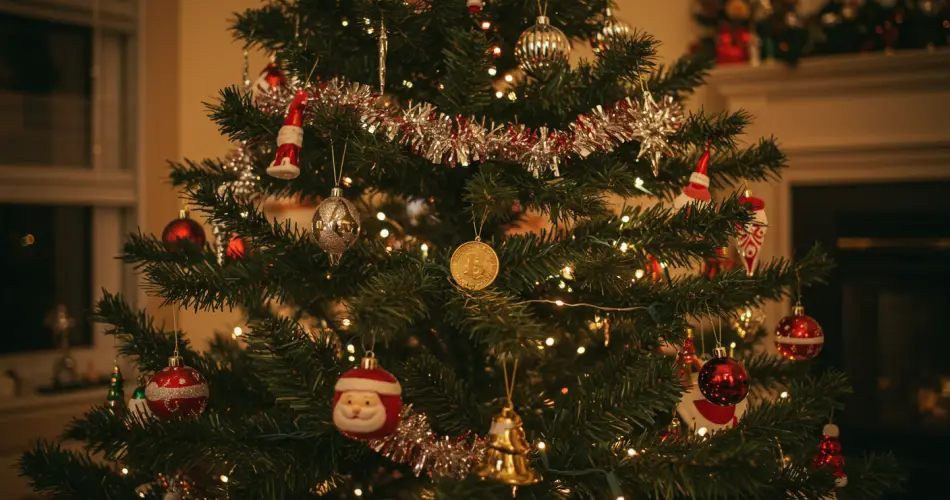As the holiday season draws near, homes and streets begin to sparkle with festive decorations. Christmas lights illuminate entire neighborhoods, while inside, the warm glow of ornaments and tinsel sets the perfect atmosphere for family gatherings. Between the nativity scene and the Christmas tree, every household has its own traditions — some display both, while others choose just one, often due to limited space. Yet, this year, a curious new custom has caught everyone’s attention: placing a coin inside the Christmas tree.
At first, it might sound like a simple decorative idea or even a superstition, but this small gesture carries a much deeper meaning. More and more families across Italy — and even beyond — are adopting this practice, believing it can bring prosperity, happiness, and good luck for the year to come.
The Spirit of the Season
Christmas is a time for family, sharing, and gratitude. Despite economic challenges that many households are facing, people rarely give up the joy of exchanging gifts or gathering around a festive table. Whether it’s a large family feast or a simple dinner with loved ones, the season is about warmth and connection.
Even when budgets are tight, many turn to thoughtful, handmade, or symbolic gifts. Secret Santa exchanges are common, making it possible for everyone to participate in the magic of giving. And it’s within this context of togetherness and hope that the new “coin in the tree” tradition is gaining ground — a simple yet meaningful way to attract good fortune and positive energy.
The Story Behind the Christmas Tree
Before we explore the reason for the coin, it’s worth remembering where the Christmas tree itself comes from. The tradition, as we know it today, became popular thanks to Queen Victoria and Prince Albert of England in 1848. A famous illustration published in a London newspaper depicted the royal family gathered around a beautifully decorated tree — an image that inspired countless British households to follow suit.
However, the tree’s true origins go back much further. Many historians trace it to 16th-century Germany, where devout Christians brought evergreen trees into their homes to symbolize eternal life. Over time, the custom spread throughout Europe, taking on different local characteristics. In Italy, for example, the Christmas tree became a beloved symbol of light, rebirth, and family unity, complementing the nativity scene — another cornerstone of the season.
Decorating Traditions Through the Years
Early Christmas trees were much simpler than today’s glittering displays. Instead of shiny baubles and electric lights, they were adorned with fruits like apples, nuts, sweets, and small gifts. These items symbolized abundance and generosity — key values of the holiday season.
As time passed, decorations evolved. Modern trees now feature a dazzling array of ornaments: colorful balls, snowflakes, garlands, candy canes, pinecones, ribbons, and sparkling lights. Some people prefer a traditional green tree, while others go for snow-dusted or artificial versions in white, gold, or even pink.
Color themes also change each year, following fashion trends. One season might favor gold and red, the next silver and blue. Whether minimalist or extravagant, every Christmas tree tells a story — one of family, creativity, and tradition.
The Meaning of the Coin Tradition
But what about the coin? Why are so many people suddenly slipping a shiny piece of metal among the branches of their Christmas tree?
According to popular belief, placing a coin in the tree is an ancient gesture meant to attract good fortune, abundance, and positive energy into the home. Much like the custom of tossing coins into a fountain while making a wish, this simple act symbolizes a hopeful beginning for the new year.
The idea is to wrap a small coin — it doesn’t matter which denomination — in red paper, as red is considered a powerful color that wards off negativity and invites prosperity. Then, tie it with a ribbon or string and hang it on the tree, just like any other ornament. The coin doesn’t need to be visible; it can be hidden among the branches, serving as a discreet charm of luck and protection.
The Symbolism of Red and Gold
In many cultures, red and gold are seen as lucky colors, especially during festive periods. Red represents life, vitality, and energy, while gold is associated with wealth and success. By wrapping your coin in red paper, you’re essentially combining both forces — calling in good fortune and safeguarding your home against bad luck.
This tradition also ties into a broader human tendency to use symbols of prosperity during times of transition, such as New Year’s Eve. Just as some people eat lentils or hang mistletoe for luck, the coin in the Christmas tree is a gesture rooted in optimism — a small but powerful act of faith in better days to come.
A Modern Twist on an Ancient Belief
Even though the origin of this practice is not tied to one specific culture, similar customs can be found around the world. In some European countries, coins have long been used in holiday rituals: placed in Christmas puddings, baked into loaves of bread, or hidden under plates at festive dinners. The person who finds the coin is said to be blessed with wealth and happiness for the coming year.
The Christmas tree coin, therefore, can be seen as a modern, decorative version of that old idea — one that blends seamlessly with contemporary traditions while keeping the charm of folklore alive.
A Simple Act with a Powerful Message
At its heart, the coin-in-the-tree tradition isn’t just about superstition or money. It’s about gratitude for what we have and hope for what’s to come. Hanging that small, wrapped coin among the ornaments reminds us to stay positive, to believe in renewal, and to open our hearts to good fortune — not just material, but emotional and spiritual as well.
So, when you’re decorating your Christmas tree this year, consider adding your own lucky coin. Whether you believe in omens or simply love meaningful traditions, this small gesture could become a cherished part of your family’s holiday celebrations — one that brings a little extra sparkle and perhaps, a touch of magic to your festive season.



